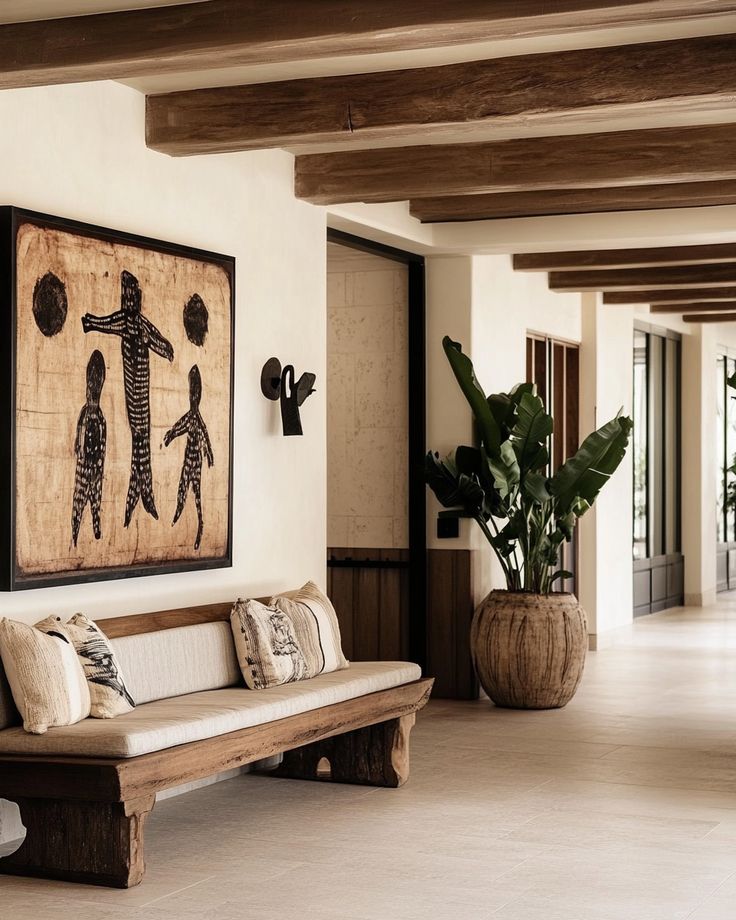
Celebrate Culture and Tradition in Interior Design
Infusing your surroundings with culture and tradition transforms your home into a warm, meaningful space. It creates an atmosphere of belonging and authenticity that touches every corner of your home. Because I stay deeply connected to my West African roots, I incorporate its influence into everything I create. This is why I passionately promote sustainable African textiles in my interior design work.
Using sustainable African textiles in home décor not only benefits the environment but also enriches spaces with cultural heritage and bold design. West African textiles, in particular, feature striking patterns, vivid colors, and rich textures that turn any interior design project into a masterpiece.
The Cultural Heritage of African Textiles
For centuries, artisans across Africa have woven textiles that reflect cultural identity, social status, and storytelling traditions. Families have passed down these time-honored techniques, ensuring that each textile holds history and meaning. These fabrics go beyond decoration—they preserve African culture and craftsmanship, showcasing the artistry of the communities that create them.
Popular West African Textiles That Elevate Interior Design
1. Kente Cloth: A Royal Legacy from Ghana
Kente cloth stands as one of the most recognizable African textiles, found in nearly every Ghanaian household. According to legend, two Ashanti weavers, Kurugu and Ameyaw, observed a spider weaving its web and felt inspired to develop a groundbreaking weaving technique. Their innovation led to Kente cloth, a fabric symbolising the Ashanti Kingdom’s wealth, wisdom, and status.
Key Characteristics:
- Narrowly woven strips sewn together to form larger fabric pieces.
- Vibrant, multicolored patterns that convey symbolic messages.
- Geometric designs representing social status, historical events, and philosophy.
Design Tip: Incorporate Kente cloth into upholstery, framed artwork, or decorative pillows to infuse West African heritage into your décor.
2. Mudcloth: A Symbol of History and Protection
Malian artisans handcraft Mudcloth (Bògòlanfini) using a traditional fermented mud-dyeing process. This method creates striking geometric patterns in earthy shades of black, white, and brown.
Key Characteristics:
- Handwoven cotton fabric dyed with natural ingredients.
- Symbolic motifs representing historical events, social identity, and protection.
- Textured patterns that add depth and warmth to interiors.
Design Tip: Use Mudcloth in wall art, throws, or reupholstered furniture to introduce rustic elegance into your space.
3. Aso Oke: Nigerian Prestige in Interior Design
Nigerian artisans create Aso Oke, a luxurious handwoven textile deeply embedded in Yoruba traditions. Woven on narrow looms, this fabric carries intricate embroidery, metallic threads, and vibrant colors. Traditionally worn during weddings and ceremonial events, Aso Oke now appears in high-end interior design as a sign of cultural sophistication.
Key Characteristics:
- Rich textures created with cotton, silk, or synthetic fibers.
- Intricate patterns that add elegance and refinement.
- Highly durable material ideal for upholstery and statement pieces.
Personal Tip: Use Aso Oke as curtain panels, decorative cushions, or luxurious bed throws to introduce depth and tradition into your home.
How to Incorporate African Textiles into Interior Design
1. Upholstery & Soft Furnishings: Bring Depth and Comfort
Reupholster armchairs or ottomans with Kente cloth or Aso Oke to introduce bold colors and rich textures into your living space. Alternatively, layer your sofa with Mudcloth throw pillows and woven blankets for an effortlessly elegant and inviting look.
2. Wall Hangings & Framed Textile Art: Create a Cultural Focal Point
Instead of conventional artwork, frame Mudcloth or Kente cloth to make a powerful design statement. You can also hang large African textiles as tapestries to add warmth, depth, and cultural storytelling to your walls.
3. Table Linens & Curtains: Elevate Everyday Elegance
Incorporate Aso Oke table runners, placemats, and napkins into your dining space for a luxurious yet cultural ambiance. If you want to create a warm and textured aesthetic, consider using Mudcloth curtains that soften natural light while adding visual interest.
4. Rugs & Floor Coverings: Functional and Stylish Accents
Transform African textiles into unique rugs or floor coverings that create a statement in high-traffic areas. Kente and Mudcloth make excellent options due to their durability and intricate designs, ensuring they serve as both artistic and practical additions.
Personal Tip: Layer multiple African textiles across furniture, walls, and floors to create a cohesive, globally inspired interior.
Why Choose Sustainable African Textiles for Home Décor?
Beyond aesthetics, African textiles support eco-conscious living and ethical craftsmanship.
Eco-Friendly Production: Many handwoven African fabrics use natural dyes, organic fibers, and low-waste production methods, making them a sustainable design choice.
Empowers Artisan Communities: Purchasing authentic African textiles directly supports local weavers and ethical trade markets.
Unique, One-of-a-Kind Designs: Unlike mass-produced fabrics, each African textile carries a distinct story, adding authenticity and cultural depth to interiors.
It’s handy to know: As demand for sustainable luxury continues to rise, interior designers and homeowners increasingly prioritise handcrafted, ethically sourced textiles in their projects.
Final Thoughts on Enriching Your Home with African Textiles
African textiles offer more than visual beauty—they bring history, craftsmanship, and sustainability into modern interiors. Whether you choose bold Kente cloth, earthy Mudcloth, or luxurious Aso Oke, these fabrics infuse homes with meaning, warmth, and artistic expression.
By incorporating African-inspired textiles, you create a timeless and culturally rich space that reflects personal style and global appreciation for craftsmanship.
Start your design journey today—transform your home with the cultural elegance of African textiles!
If you enjoyed this don’t forget to check out our work on Instagram. You may find something to inspire you!
+ view the comments



